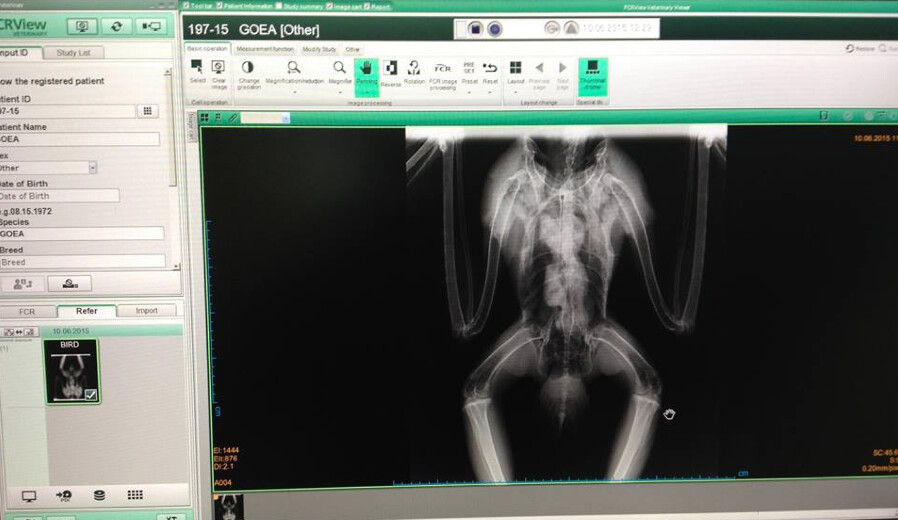Digital X-Ray Improves Raptor Rehab, Give Big Gallatin Valley Spurs Purchase
Thursday Dec. 31st, 2015
The key to rehabilitating wounded wildlife is understanding the extent of an animal’s injuries. At the Montana Raptor Conservation Center (MRCC), this step just got a lot easier thanks to the non-profit’s new digital x-ray machine.
When an injured raptor is admitted, MRCC staff stabilize it and perform an initial assessment, which most often involves an x-ray, explains Director Becky Kean. “The images produced by digital x-ray are far superior to those produced on traditional film, which allows us to really target our efforts. Hollow bird bones shatter on impact and leave lots of tiny fragments. With this technology, we can see the fine detail and determine a plan of attack,” she says. The plan could involve setting the bone with splints and tape or surgically with pins.
A golden eagle with a shoulder fracture was one of the first patients to be diagnosed using the new x-ray technology. “We were able to see through the scapula and coracoid into the joint to identify the damage—the detail was impressive,” Kean continues. “Having that visual really helped us set the joint and give the eagle a better chance at recovery and release.”
The digital x-ray is also efficient, adds MRCC Assistant Director Jordan Spyke. “In the past, we’d have to develop film and drive it to the vet for analysis. Now, we can e-mail a digital image in less than half the time. That shortens the entire diagnostic process, and gives us more time to tend to the birds,” he says. “It also saves on supply costs because digital x-rays aren’t developed with chemicals like film is.” Both Spyke and Kean appreciate the reduced exposure to harsh chemicals and radiation associated with traditional x-ray.
“Despite offering both clinical advantages and operational efficiencies, MRCC is the only raptor rehabilitation center in the state with such a high-tech tool, and that’s largely because of the purchase price,” explains MRCC Board President Rick Sanders. “We are fortunate that so many supporters helped us take this significant step. The Gallatin Valley really ‘gave big’ for the digital x-ray this spring, which was a huge push toward our goal.”
Sanders explains that a majority of the funds needed to purchase the technology came in during the inaugural Give Big Gallatin Valley, a one-day community fundraising event that brought in more than $235,000 for 100 local non-profits. “The increased awareness from that day gave us the momentum we needed to meet our goal,” says Sanders, noting that additional funds came from generous matching funds, individual donors, and our friends at the Sacajawea Audubon.
“Although it required a large investment, we’re certain this technology will be worthwhile in the long run,” Sanders continues. “It saves on two critical resources: money and time. And, that efficiency makes it possible to care for more birds.”
The advantages couldn’t have come at a better time, according to Kean, since MRCC is on pace to break every admission record since it was founded in 1988. “We have treated 230 this year,” she says. “That’s up almost 25% over 2014 when we treated a total of 190 raptors.” It’s difficult to tease out what’s driving the increase—changes in breeding and migration patterns, increased awareness about the Center, or something else—but Kean and Spyke are prepared to rehabilitate and release as many wild birds of prey as they can.
“Thanks to everyone out there who supports us,” Kean says, “2015 has been a great year and we couldn’t do it without you!”
| Tweet |